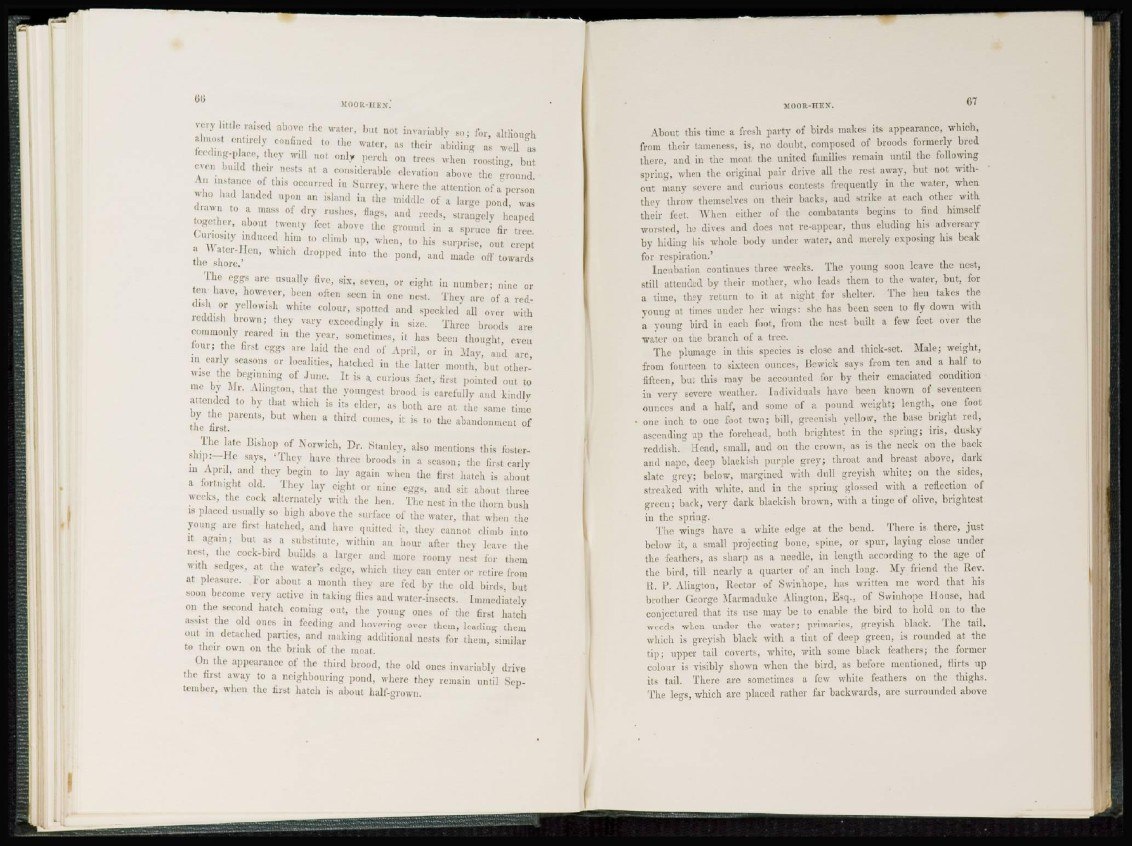
66 MOOR-HEN.'
very little raised above the water, but not invariably so; for, although
almost entirely confined to the water, as their abiding as well as
feeding-place, they will not only perch on trees when roosting, but
even build their nests at a considerable elevation above the ground.
Au instance of this occurred in .Surrey, where the attention of a person
who had landed upon an island in the middle of a large pond, was
drawn to a mass of dry rushes, flags, aud reeds, strangely heaped
together, about twenty feet above the ground in a spruce fir tree.
Curiosity induced hiui to climb np, when, to Ins surprise, out crept
B Water-1 len, which dropped into the pond, and made off towards
the shore.'
The eggs are usually five, six, seven, or eight in number; nine or
ten have, however, been often seen in one nest. They are of a redd
i s h or y e l l o w i s h white colour, spotted and speckled all over with
reddish brown; they vary exceedingly in size. Three broods are
commonlj reared in tin1 year, sometimes, it has been thought, even
four; the first eggs are laid the end of April, or in May, and are,
in early seasons or localities, hatched in the latter month, but otherwise
the beginning of June. It is a, curious fact, first pointed out to
me by Mr. Aliugton, that the youngest brood is carefully and kindly
attended to bv that which is i t s elder, as both are at the same time
by the parents, but when a third comes, it is to the abandonment of
the first.
The late Bishop of Norwich, Dr. Stanley, also mentions this fostership:—
He says, 'They have three broods in a season; the first early
in April, and they begin to lay again when the first hatch is about
a fortnight old. They lay eight or nine eggs, and sit about three
weeks, the cock alternately with the hen. The nest in the thorn bush
is placed usually so high above the surface of the water, that when the
young are first hatched, and have quitted it, they cannot climb into
it again; but as a substitute, within an hour after they leave the
nest, the cock-bird builds a larger and more roomy nest for them
with sedges, at the water's edge, which they can enter or retire from
at pleasure. For about a month they are fed by the old birds, but
soon become very active in taking flies and water-insects. Immediately
on the second hatch coming out, the young ones of the first batch
assist the old ones in feeding and hovering over them, leading them
out in detaehed parties, and making additional nests for them, similar
to their own on the brink of the moat.
On the appearance of the third brood, the old ones invariably drive
the first away to a neighbouring pond, where they remain until September,
when the first hatch is about half-grown.
M O O R - H E N . <57
About this time a fresh party of birds makes its appearance, which,
from their lameness, is, no doubt, composed of broods formerly bred
there, and in the moat the united families remain until the following
spring, when the original pair drive all the rest away, but not without
many severe and curious contests frequently in the water, when
they throw themselves on their backs, aud strike at each other with
their feet. When either of the combatants begins to find himself
worsted, he dives and does not rc-appear, thus eluding his adversary
by hiding his whole body under water, and merely exposing his beak
for respiration.'
Incubation continues three weeks. The young soon leave the nest,
still attended by their mother, who leads them to the water, but, for
a time, they return to it. at night for shelter. The hen takes the
young at times under her wings: she has been seen to fly down with
a voting bird in each foot, from the nest built a few feet over the
water on the branch of a tree.
The plumage in this species is close and thick-set. Male; weight,
from fourteen to sixteen ounces, Bewick says from ten and a half to
fifteen, but this may be accounted for by their emaciated condition
in very severe weather. Individuals have been known of seventeen
ounces and a half, and some of a pound weight; length, one foot
one inch to one foot two; bill, greenish yellow, the base bright, red,
ascending up the forehead, b:ith brightest in the spring; iris, dusky
reddish. Head, small, aud on the crown, as is the neck on the back
and nape, deep blackish purple grey; throat and breast above, dark
slate grey; below, margined with dull greyish white; on the sides,
streaked with white, and in the spring glossed with a reflection of
green; back, very dark blackish brown, with a tinge of olive, brightest
in the spring.
The wings have a white edge at the bend. There is there, just
below it, a small projecting bone, spine, or spur, laying close under
the feathers, as sharp as a needle, in length according to the age of
the bird, till nearly a quarter of an inch long. My friend the Rev.
II. P. Alington, Rector of Swinhope, has written me word that his
brother George Marmadukc Alington, Esq., of Swinhope House, had
conjectured that its use mav be to enable the bird to hold on to the
weeds when under the water; primaries, greyish black. The tail,
which is greyish black with a tint of deep green, is rounded at the
tip; upper tail coverts, white, with some black feathers; the former
colour is visibly shown when the bird, as before mentioned, flirts up
its tail. There are sometimes a few white feathers on the thighs.
The legs, which are placed rather far backwards, are surrounded above